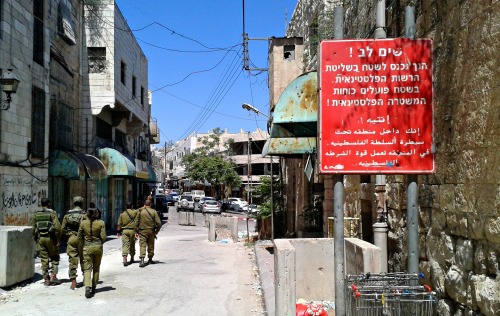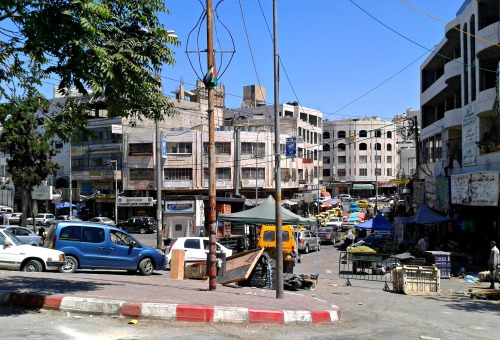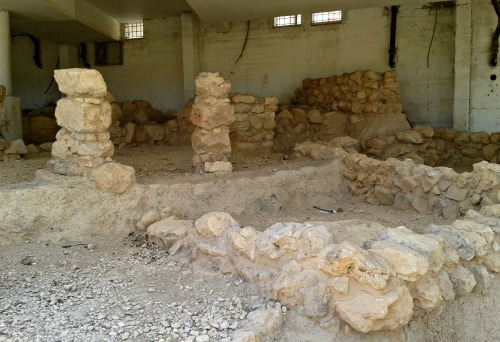Taking the liberty of chronologically skipping some posts that I simply haven’t gotten around to writing and are long overdue, this is a summary of a really interesting day I had last week in Hevron (Hebron), of which I am quite eager to share. I started my day in the very Anglo town of Efrat, just south of Jerusalem, at the very start of the ongoing Operation Protective Edge. Without getting to into too much military detail, I then drove further south through Kiryat Arba and then into Hevron – quite an interesting drive. This drawing by Scotsman David Roberts does not at all depict how the drive was, but it is a nice drawing:
I thoroughly enjoyed driving the narrow, winding Old City streets and then passing Me’arat HaMachpelah (Cave of the Patriarchs) where key Biblical couples such as Adam & Eve and Abraham & Sarah are buried – a place I have not yet merited to visit. Continuing on down al-Shuhada street, we then turned up Tarpat street towards Tel Rumeida – where some antiquities and some Jews can be found. The first thing I noticed were the signs and the excavated ruins beside and beneath a housing building. Tel Rumeida is what’s left of the Biblical Hebron – a very important city in Judaism and King David’s first capital city. King David’s own father and great-grandmother, Yishai (Jesse) and Ruth, are even buried locally at Tel Rumeida. Excavations began in 1999 and the findings are remarkable: a huge wall built some 4,500 years ago, another wall from some 3,800 years ago and ruins of the ancient city with remnants from the times of the Kingdom of Judah and the Second Temple period.
Before spending time at the ruins I popped up into the tiny military outpost, set up to protect the local Jewish population, and headed for the tomb of Ruth and Yishai. On the way I saw the tiniest vineyard, it made me wonder how tasty the wine would be…
Beside the tomb pictured above, there is the ruins of an ancient synagogue and unlike any other ruined synagogue, this one is being brought back to into use, which is smart.
Leaving the holy site, I walked down to Tarpat Junction to gain some knowledge from the soldiers guarding at the checkpoint. They began to explain to me the dangers of the city; that every night there is rioting on the other side of the checkpoint, in the Arab-only Palestinian-controlled part of Hevron. I peered through the bulletproof glass and saw the rocks littered all over – probably recycled each night. What makes Hevron so volatile is that it is the only city in Palestinian control that is also inhabited by Jews, and therefore partially in Israeli control. The Palestinian controlled section of Hevron is known as H1 (in which no Jews are allowed) and the Israeli controlled section of Hevron is known as H2 (in which Arabs are partially allowed) – a real mess. While I was learning all this a jeep pulled up and three officers strode up. I was startled to see a brigadier general approaching, later identified by myself as BG Tamir Yadi, commander of the Judea and Samaria region. He was accompanied by a colonel whose identity I don’t know, and a female lieutenant – probably his aide. The general wanted to go into H1 and so I decided to tag along…
It felt really strange entering the Palestinian controlled area, passing the sign warning that Palestinian police have authority. We walked to the next junction and stood as spectators as the senior officers talked. I peered into a grocery store, watched traffic, spied a butcher blow-torching chickens, having a very Arab experience. I felt like I was a tourist in Egypt or Syria – but with an M16 at my hip – I didn’t spot any Hebrew anywhere, nothing glaringly Israeli. Suddenly an old man in traditional Arab garb and headpiece, with a cane gripped in his right hand, walked by and stopped by the senior officers to pay respects. I heard Arabic mumblings and then the officers wished the old man a “happy Ramadan” and away he shuffled.
The general decided that he had enough spectating and we walked back to H2, where the officers got back into their jeep and drove away. I bid farewell to the guards and walked back up Tarpat street to continue exploring Tel Rumeida. I stopped at the first ruins and got a better look. This here is residential structure from about 4,500 years ago and a “Four-Room House” from the time of Hezekiah, King of Judah some 2,700 years ago:
I then found the lookout to Me’arat HaMachpela, in a grassy plot with some olive trees, and I gazed out at the world’s most ancient tomb – so close yet so out of reach (at the moment in my day).
Convinced that there was more, that I simply wasn’t looking well enough, I began to explore. First I came upon an old rusted blue Schweppes delivery truck, then someone’s wine press and so I returned to the area of the tomb and the synagogue. While there I heard someone call out, in English, “Soldier, soldier!” I turned around and saw some people standing in an elevated garden calling out to me, cameras in their hands. I asked them what they wanted and they demanded that I remove the Jewish settlers from their land. Not wanting to get into some heated argument about a plot of land I knew nothing about, I explained that this was a very interesting moment for me and that I was sorry that they felt the way they did, probably not such good footage for their usages…
Exploring from a different approach up the hill, I stumbled upon the Antiquities Authority’s latest excavation but unfortunately it was gated and locked and there was nobody there for me to sweet-talk my way in. But while I was there, walking on a dirt path towards the al-Arba’in mosque, I found myself looking down on the ancient Jewish cemetery which had been in use for hundreds and hundreds of years until 1936 when the local Jews were evacuated by the British.
With so much more to say about Hevron, including camera-wielding Swedes and the trials and tribulations of Yusuf Aza who just couldn’t remember to bring his ID and clearance pass with him to enter the Jewish cul-de-sac, I fear for being long-winded and I shall therefore bring this adventure to a close. Hopefully one day soon I’ll get to visit the parts I couldn’t catch this time around…









